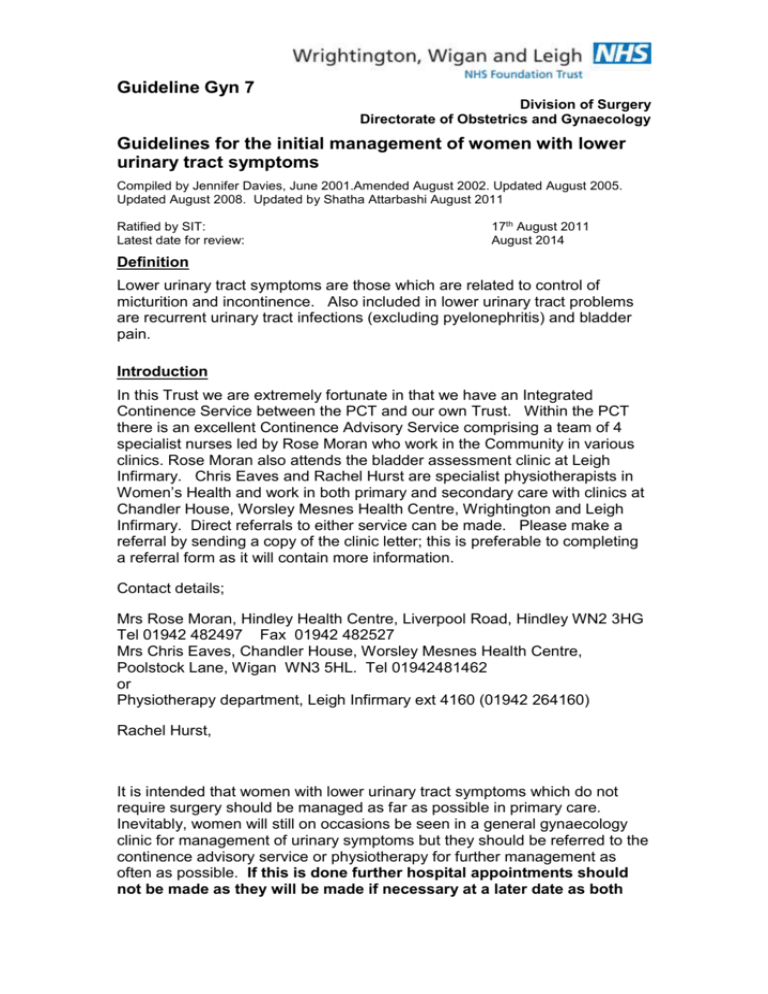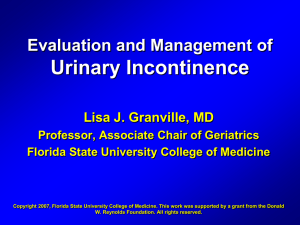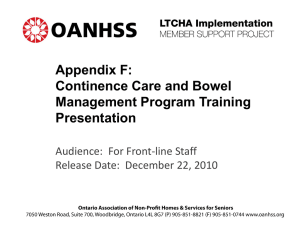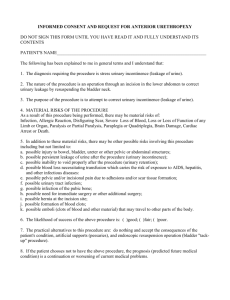Urinary Symptoms Initial Management
advertisement

Guideline Gyn 7 Division of Surgery Directorate of Obstetrics and Gynaecology Guidelines for the initial management of women with lower urinary tract symptoms Compiled by Jennifer Davies, June 2001.Amended August 2002. Updated August 2005. Updated August 2008. Updated by Shatha Attarbashi August 2011 Ratified by SIT: Latest date for review: 17th August 2011 August 2014 Definition Lower urinary tract symptoms are those which are related to control of micturition and incontinence. Also included in lower urinary tract problems are recurrent urinary tract infections (excluding pyelonephritis) and bladder pain. Introduction In this Trust we are extremely fortunate in that we have an Integrated Continence Service between the PCT and our own Trust. Within the PCT there is an excellent Continence Advisory Service comprising a team of 4 specialist nurses led by Rose Moran who work in the Community in various clinics. Rose Moran also attends the bladder assessment clinic at Leigh Infirmary. Chris Eaves and Rachel Hurst are specialist physiotherapists in Women’s Health and work in both primary and secondary care with clinics at Chandler House, Worsley Mesnes Health Centre, Wrightington and Leigh Infirmary. Direct referrals to either service can be made. Please make a referral by sending a copy of the clinic letter; this is preferable to completing a referral form as it will contain more information. Contact details; Mrs Rose Moran, Hindley Health Centre, Liverpool Road, Hindley WN2 3HG Tel 01942 482497 Fax 01942 482527 Mrs Chris Eaves, Chandler House, Worsley Mesnes Health Centre, Poolstock Lane, Wigan WN3 5HL. Tel 01942481462 or Physiotherapy department, Leigh Infirmary ext 4160 (01942 264160) Rachel Hurst, It is intended that women with lower urinary tract symptoms which do not require surgery should be managed as far as possible in primary care. Inevitably, women will still on occasions be seen in a general gynaecology clinic for management of urinary symptoms but they should be referred to the continence advisory service or physiotherapy for further management as often as possible. If this is done further hospital appointments should not be made as they will be made if necessary at a later date as both teams can refer directly into the bladder assessment clinic or for urodynamics without a further referral from a GP. If further hospital management is required this will usually be in the bladder assessment clinic at Leigh Infirmary. Guidelines A. General Action 1. 1An abdominal and pelvic examination should be performed Rationale To exclude the presence of masses To exclude an overdistended bladder To establish whether there is any tenderness of the urethra and bladder To identify any concomitant prolapse (remembering this may be coincidental and not the cause of the urinary tract symptoms) 2. 2Neurological abnormalities which may be contributing to the symptoms should be excluded as far as possible by history with or without a brief neurological examination. Neurological abnormalities are commonly associated with bladder symptoms as a result of neurogenic detrusor overactivity (previously detrusor hyperreflexia) 3. 3MSU should be sent for culture prior to any investigations Any infection should be adequately treated and the urine re-tested before proceeding with investigations Initial management urinary symptoms (Gyn 7) Latest date for review August 2014 2 4. 4Consider cystoscopy prior to other investigations in cases of: To exclude malignancy or other pathology a) frank haematuria without infection b) sterile pyuria on two separate occasions (when not taking antibiotics) c) bladder pain and no other urinary symptoms at all (UDS may still be useful especially if the cystoscopy is negative) B. Specific Situations 1. Recurrent urinary tract infections Action 1. 1Exclude glycosuria Rationale Sugar provides an excellent culture medium for bacteria 2. 2Refer to bladder assessment clinic to ascertain normal voiding Long term residual urine promotes UTIs 3. 3Commence treatment with 3 months rotating antibiotics e.g. 1 month each of 3 of the following: If the bladder remains infection free for some months the bladder mucosa becomes less inflamed and therefore less prone to infection Trimethoprim 200 mgs daily Nitrofurantoin 50mg daily Norfloxacin 400 mgs. daily Cefalexin 250mg daily Amoxycillin 250mg daily Doxycycline 100mg daily Ciprofloxacin 250mg daily Ofloxacin 200mg daily 4. 4If voiding is abnormal try to improve voiding (urethral dilatation, intermittent self catheterisation ) +/- antibiotics as above 5. 5If there are further infections despite this arrange cystoscopy Initial management urinary symptoms (Gyn 7) Latest date for review August 2014 Reduction of residual urine reduces infection rates (retained urine can provide an excellent culture medium for infection even in the absence of sugar) To exclude other pathology within the bladder 3 6. 6If other urinary symptoms persist when infection free, arrange full urodynamics Infection is clearly not the only cause of urinary symptoms in this situation 2. Symptoms suggestive of idiopathic detrusor overactivity (previously detrusor instability) Action 1. 1MSU a) treat any infection and repeat b) if negative proceed to 2 2. 2Treat with low dose antibiotics for 3 months (trimethoprim 200mg nocte) if any of the following are present Rationale Infections are the commonest cause of all urinary symptoms Chronic inflammation within the bladder and urethra is a common cause of lower urinary tract symptoms a) feeling of cystitis or bladder discomfort b) tender urethra or bladder base c) voiding difficulties d) symptoms provoked initially by a UTI Review after 2 months usually by referring to the Continence Advisory Service (copy the letter to the GP to Rose Moran, Clinical Nurse Specialist Continence by way of a referral for follow up) a) if no improvement try alternative treatments as below b) if improved continue for full 3 months then discontinue and review 2-3 months after stopping Initial management urinary symptoms (Gyn 7) Latest date for review August 2014 Benefit is usually experienced after 6 – 8 weeks 4 3. 3If none of the above are present prescribe trial of an anticholinergic for at least 6 weeks. Available anticholinergics are: Detrusitol XL 4mg od (tolterodine) Lyrinel XL 10-15mg od (oxybutynin) Vesicare 5mg od (solifenacin) Regurin 20mg bd (trospium) Detrunorm 15mg tds (Propiverine) also available as Detrunorm XL 30mg od Emselex 7.5mg od (darifenacin) Toviaz 4mg and 8mg od (Fesoterodine Fumarate) Warn about side effects and give patient information leaflet (tablets used to treat bladder problems) mentioning that they may reduce with time but if they are intolerable stopping the tablets will lead to a resolution within a few days. Dry mouth Constipation Indigestion Dry eyes Blurred vision Request review by the Continence Advisory Service (send a copy of the letter to the GP to Rose Moran, Clinical Nurse Specialist Continence). 4. If anticholinergics have been commenced and are effective then continue for 6 months but also refer to Continence Advisory Service as above for bladder retraining. Initial management urinary symptoms (Gyn 7) Latest date for review August 2014 If anticholinergic agents are beneficial then it is likely that the diagnosis is idiopathic detrusor overactivity (previously detrusor instability) and urodynamic studies are not required if the patient is cured. Choose a once daily anticholinergic as a first option as compliance with these is better. NOTE solifenacin and darifenacin have longer half lives than the others and if changing from solifenacin or darfinacin to another anticholinergic a one week break from treatment is required before starting the new medication. Oxybutynin is also available as a transdermal preparation 1 patch twice a week delivering 3.9mg daily, this preparation may reduce side effects. The team at the Continence Advisory Service are experts in the management of these problems and can review patients in the community. If bladder retraining is effective the anticholinergics may be able to be reduced or even stopped. 5 5. 4 If the above measures have not resulted in a satisfactory improvement, commence an alternative anticholinergic and refer to the bladder assessment clinic. If the patient declines treatment with tablets refer to the bladder assessment clinic. If the patient has already had 3 months of empirical treatment with at least 2 anticholinergics refer for full urodynamic studies. In the bladder assessment clinic the history can be reviewed with the benefit of input/output charts. Voiding can be investigated. Urodynamics provide objective evidence of the cause of bladder symptoms. 6. 5The following issues will be addressed in the bladder assessment clinic if voiding is abnormal try to improve voiding (urethral dilatation, intermittent self catheterisation) +/- antibiotics as above if voiding is normal consider bladder and fluid intake education bladder retraining low dose antibiotics if appropriate trial of alternative anticholinergics The same measures as above will be employed but review will take place in a clinic dedicated to these problems with more time to review the entire history once again 3. Symptoms suggestive of pure stress incontinence Action 1. 1MSU - treat any infection and repeat Rationale Infection may cause symptoms which masquerade as stress incontinence 2. 2If MSU negative refer for physiotherapy Physiotherapy is the first treatment of choice for stress incontinence Initial management urinary symptoms (Gyn 7) Latest date for review August 2014 6 3. Duloxetine may be offered as a second line therapy if women prefer pharmacological to surgical treatment, or if not suitable for surgery. The full dose is 40mg bd but it can be commenced at 20mg od to reduce side effects, gradually increasing to the full dose (20mg od for 3 days, 20mg bd for 3 days, 20mg od and 40mg od for 3 days, 40mg bd). If no beneficial effect after 3 weeks on the full dose it is unlikely to be effective. It probably works better combined with physiotherapy. Duloxetine is a Serotonin Noradrenaline Reuptake inhibitor which improves tone of external urethral sphincter. It treats stress incontinence with a 50% reduction in episodes. It was introduced in November 2004. The data sheet initially suggested starting at 40mg bd and reducing as necessary but more recent company advice has suggested the approach outlined here. Nausea is the most problematic side effect. If discontinuing after more than 1 week of therapy reduce slowly to avoid rebound mood swings Watch with SSRIs Not with MAOIs Not with fluvoxamine or ciproflaxacin (inhibit CYP1A2) 4. 3Refer for full urodynamics prior . to surgery if physiotherapy fails or is refused. As physiotherapy facilities are limited within the Trust consider referring for urodynamics if stress incontinence is very severe i.e. demonstrable in clinic with an empty bladder. As the bladder is an “unreliable witness” stress incontinence should be proven to be urodynamic stress incontinence (previously genuine stress incontinence) by urodynamic studies prior to surgery. This is absolutely essential in cases where repeat surgery is planned 4. Symptoms suggestive of mixed incontinence Action 1. 1 Manage as for idiopathic detrusor overactivity (previously detrusor instability) combined with physiotherapy Rationale Detrusor overactivity should be controlled if possible prior to surgery. Physiotherapy can treat idiopathic detrusor overactivity as well as stress incontinence 2. 2Refer for full urodynamics before considering surgery To establish the relative contribution from both components of the incontinence Initial management urinary symptoms (Gyn 7) Latest date for review August 2014 7 3. 3If the idiopathic detrusor . overactivity (previously detrusor instability) has been controlled with medication then urodynamic studies should be performed whilst taking medication Usually medication is discontinued for urodynamics to evaluate the extent of the detrusor overactivty but in this case it is only the stress incontinence component which is being evaluated as medication can be continued post operatively. References: Abrams P ( 2006. Urodynamics. 3rd edition. Springer. Urinary incontinence: The management of urinary incontinence in women. NICE Clinical Guideline No. 40 (October 2006). Initial management urinary symptoms (Gyn 7) Latest date for review August 2014 8







